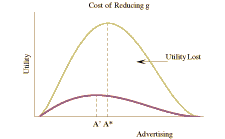Modeling the Cost of Land Use Regulation
 Government intervention in the market is a fact of life. Examples of social policy that affect land value include zoning, rent control, design constraints, environmental restrictions, historic overlays, to name only a few.
Government intervention in the market is a fact of life. Examples of social policy that affect land value include zoning, rent control, design constraints, environmental restrictions, historic overlays, to name only a few.
A capable developer must be able to model the cost-benefit analysis of various government proposals or restrictions in order to educate policymakers about the long run consequences of their actions. In the graphic to the left the developer faces an aesthetic regulation in the form of a sign ordinance that proposes to reduce the effectiveness (g) commercial advertising by restricting the size and height of outdoor signs. He knows that the community must choose how to allocate its scare resources (tax revenue) between providing "hard" benefits such as police and fire protection and enforcing "soft" benefits such as aesthetic regulation.
The restriction on advertising has secondary consequences that affect tax collections. The aggregation of the costs and benefits produce community satisfaction in the form of "utility". The developer models an optimal amount of advertising (A*), given the constraints in place and shows how the community will suffer lost satisfaction by moving to a more restrictive level of advertising.
